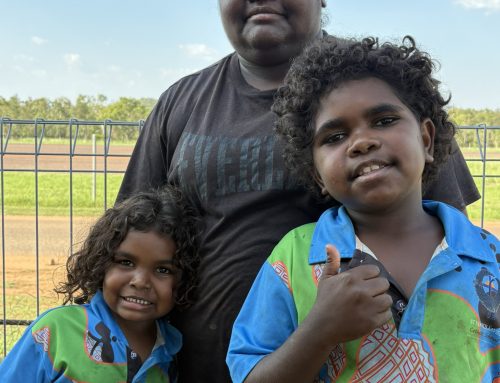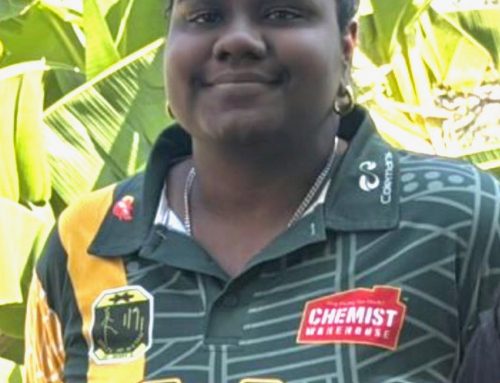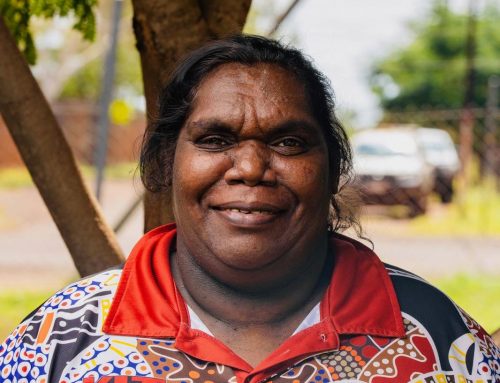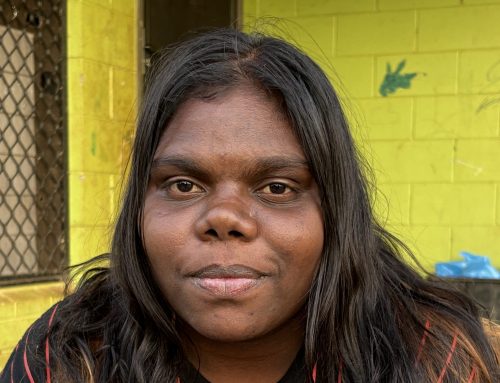Milingimbi, NT
 My name is Roslyn Markapuy. My skin name is Baŋaḏitjan and I’m Yirritja from clan group Gupapuyŋu-Birrkili.
My name is Roslyn Markapuy. My skin name is Baŋaḏitjan and I’m Yirritja from clan group Gupapuyŋu-Birrkili.
I was born at Laŋarra/Howard Island. But when I was young, we moved to Galiwin’ku and I was staying there from the 1960’s up to 1970. I was going to school there, until we moved to Milingimbi in 1974 with my grandparents, my Mum and family. We were staying first at Laŋarra and then at Milingimbi, and we were staying there until I finished my school their when I was 14-15 years old. I was going to finish my year 12 but they needed me back at the school at Laŋara and so I spent another 2 years there.
When I finished my school I started to train as an assistant teacher. I was working doing training at Milingimbi school then I went back to outstation, Laŋarra again. That was in 1980.
We were at Laŋarra with all my family and cousins and we would put out the mat, and have food, oysters, mayapl. When my last grandfather was still alive he taught all his oldest brothers granddaughters and grandsons, everyone all together in one bundle. He told us the story of how Missionaries came to Milingimbi after WWII. He was sharing our stories of what was happening at that time. We were really amazed hearing those stories. He was even sharing those stories how our olden people were living, what they were doing and it was like shifting around to other places. Like my grandfather, the oldest one. He is a good man, and really kind hearted. He told us all the stories, the dreamtime stories about how the land was created, about those two Djankawu sisters, when they were going from sunrise to sunset. We would hear these stories around the fire at the outstation. Now when we live with all the lights on, we forget these stories. If we are living at outstation we can remember these stories of how missionaries came and share these knowledge of these people and this is how we work together Yolŋu and balanda together.
When I was at Laŋarra, we built a shelter and would use it to get all the children to school. We had no houses, we cut all the bark trees for the rain season. I had another assistant teacher helping me, Michelle Garawurra, who was my cousin-brother’s wife. During that time when I was teaching at Laŋarra, in 1988 I went to Batchelor College for my training as an assistant teacher. I went half way, but needed to stop for family reasons. That was up until 2000, when I retired from my work and back over to Milingimbi with my cousin sister and her husband Chris.
I was working then at Central School, Milingimbi, as an assistant teacher. It was really different to the outstation school, and I was moving between different classes. In the outstation school it was from 8-12noon and then finish. But Central school was from 8am to 12.30 then 1-2.30pm. After a while I didn’t like all the moving around and finished there.
After that I went to find a job at Milingimbi Clinic, and I went to Batchelor again to do my Aboriginal Health Practitioner (AHP) study. I was studying to become a Yolŋu nurse. But our tutor stopped coming and we all failed, and lost our job at the clinic. But I had still passed all those trainings that I did.
After that I changed my job to Anglicare playgroup, working with young mothers and their young kids, newborns. How they are going to treat their children, how the Mothers have to learn to survive and look after their kids. It was around 2010-11, the same thing happened again. We would do training and workshop with Anglicare in Ludmilla and Winellie. But something went wrong, because we needed a building but people from the FAST program jumped in and took the building, and so our program is gone and we were out of a job again.
After that I went back to the clinic around 2014-15 and back to Batchelor. But they closed our course at Batchelor and retuned to Gove.
I was thinking I could work at the Arts Centre. I was working there, and we were first doing the bark paintings with my Mum and my Aunty and other ladies. I’m still working their sometimes. If I’m away, there are other ladies that can come in. But when I go back, I work there, they need me. I help all the old people collect the pandanus, the dye. We have boat and car there to get out to the islands and to drive and collect everything.
We had a workshop recently – Bush Gallery at Laŋarra. People came from Lake Evella, Raminginging, Milingimbi, but not Galiwin’ku they didn’t come. They sent their equipment, baskets, but no people because they are under Marthakal.
When we finished and sent all the hollow logs and the bark paintings away, we started the weaving. Weaving mats, Dilly bags, baby basket, a bowel, string bags, fish trap (big and small ones). My Mum, she is the famous artist that won the NAATSIA award for her weaving of the Dhomala (Macassan sail). We used three people to make the string. Winding the stringybark with three sticks and three people passing it around and making those long strings. She made a second one, and it is already in America. Some people came to the Bush Gallery from America and they took that second Dhomala. That was in the morning, and in the afternoon they put clay on our foreheads and other people looked over to where our bush gallery is and they made smoking ceremony.
I now also work as a researcher with the Northern Institute, at Charles Darwin University. Firstly, working on a project to do with rangers, and their training.
Research projects:
- 2024 – Transformaing cultural and natural resource intercultural workforce capabilites in Arnhem Land (with Northern Institute, CDU)
Training:
- Aboriginal Health Practitioner, Cert III, Batchelor College
- Assistant Teacher, Cert I, Batchelor College (graduated)
- Foundation Studies, Nungalinya (graduated)
- Bible Theology Course, Nungalinya (graduated)
- Media skills training, Nungalinya
- Facts training, Nungalinya
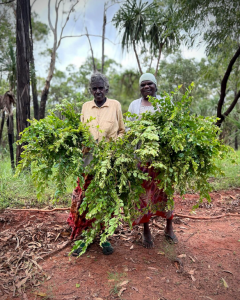
Milingimbi Weavers Judy and Roslyn working to collect dhumumu outside Bodiya outstation (photo credit: Milingimbi Art and Culture Centre)
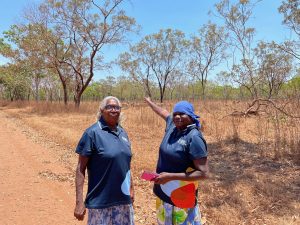
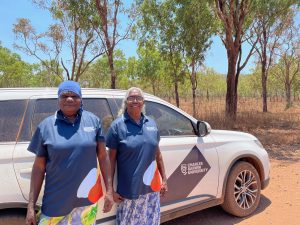
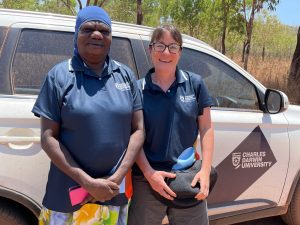
Mercy Gumbula, Roslyn Markapuy and Michaela Spencer, returning from a research trip at Barapunta/Emu Springs


